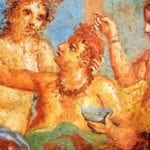 Health
Health  Health
Health  Weird Stuff
Weird Stuff Ten Surreal Attempts to Reverse Baldness
 Facts
Facts 10 U.S. Government Contingency Plans for the Unthinkable
 History
History 10 Weird Distractions from the Great Depression
 Movies and TV
Movies and TV 10 Fictional Kings Who Go from Good to Bad
 Food
Food The Fantastic Chemistry Behind Why 10 Popular Foods Taste So Good
 Technology
Technology 10 Futuristic Fungal Technologies
 History
History 10 Not-so-Spooky Events That Also Happened on October 31
 Creepy
Creepy 10 Unsettling Ghost Stories to Tell This Halloween
 Crime
Crime 10 Truly Evil People Who Used Halloween as the Perfect Cover
 Health
Health 10 Futuristic Ideas to Treat Common Medical Problems
 Weird Stuff
Weird Stuff Ten Surreal Attempts to Reverse Baldness
 Facts
Facts 10 U.S. Government Contingency Plans for the Unthinkable
Who's Behind Listverse?

Jamie Frater
Head Editor
Jamie founded Listverse due to an insatiable desire to share fascinating, obscure, and bizarre facts. He has been a guest speaker on numerous national radio and television stations and is a five time published author.
More About Us History
History 10 Weird Distractions from the Great Depression
 Movies and TV
Movies and TV 10 Fictional Kings Who Go from Good to Bad
 Food
Food The Fantastic Chemistry Behind Why 10 Popular Foods Taste So Good
 Technology
Technology 10 Futuristic Fungal Technologies
 History
History 10 Not-so-Spooky Events That Also Happened on October 31
 Creepy
Creepy 10 Unsettling Ghost Stories to Tell This Halloween
 Crime
Crime 10 Truly Evil People Who Used Halloween as the Perfect Cover
10 Incorrect Ancient Greek And Roman Theories About The Body
Working with the limited scientific knowledge they had, the ancient Greek and Roman civilizations came up with a number of theories about the human body. While some were correct, most were not. As a matter of fact, some doctors, philosophers, and thinkers got it hilariously wrong.
10 Food Was Changed Into Blood By The Liver
Originator: Galen

Perhaps the greatest Roman (though, he was of Greek ethnicity) doctor ever, Galen published a vast number of writings on the human body and proposed many correct theories. One of the incorrect ones that he believed was that food was digested by the stomach and taken to the liver, where it was turned into blood. The biggest reason for many of Galen’s errors was that he’d never dissected a human body; in his time, it was outlawed by the Roman Empire. His theories were widely followed—practically blindly—until the 16th century, when Flemish doctor Andreas Vesalius began to question Galen’s findings.
9 Lambs Grew From Trees
Originator: Megasthenes

Megasthenes was a Greek explorer who returned from a trip he took to India and wrote a book about his travels. He referred to cotton plants that he saw as “trees on which grew wool,” which led to the misconception that lambs grew on trees. From that incorrect assumption, a number of other ancient thinkers, including Theophrastus and Pliny the Elder, mentioned “wool-bearing trees” in their writings, perpetuating the myth. As late as the 18th or 19th centuries, this was still a commonly believed theory, with books published on the subject and a number of expeditions undertaken in search of the mythical plant.
8 Light Came From The Eye
Originator: Plato

Plato, one of the greatest Greek philosophers, contributed greatly to medical knowledge—erroneously in a number of cases. Perhaps his worst error was the idea that “a stream of light or fire” emanated from the eye, rebounded off of an object, and combined with sunlight, allowing it to be seen by the eye. An object’s color was said to be “flame particles” that were let off its body. This was a commonly held notion until the 11th century, when Persian scientist Ibn al-Haytham developed his theory that the eye was merely an optical instrument in his writing The Book of Optics.
7 Veins Carried Blood, Arteries Carried Air
Originator: Praxagoras

An ancient Greek physician whose writings have been lost to humanity, Praxagoras is perhaps best known for being the first to realize that veins and arteries are different. However, he believed that air traveled through the arteries (probably due to the fact that blood tends to leave the arteries upon death and accumulates in the veins). Praxagoras explained away bleeding by saying the arteries attracted blood from the neighboring tissue when exposed to air. This theory was widely believed for hundreds of years.
6 Sleep Occurs When Blood Flows Away From The Surface
Originator: Alcmaeon

Another ancient Greek philosopher and doctor, Alcmaeon of Croton was the holder of a number of medical firsts, including the idea that the brain was the seat of understanding, rather than the heart. He also theorized that sensory organs are attached to the brain. However, he wasn’t always correct. He believed that sleep came to humans when their blood flowed from the surface of their bodies to the blood vessels farther in. Alcmaeon also believed that death occurred if all of the blood went deep into the body.
5 The Brain Was Just A Cooling Device
Originator: Aristotle

Aristotle believed the heart was the center of knowledge and the source of the sensations in the human body, rather than the brain, and he had an interesting theory about the brain. He felt that the brain was merely a cooling organ for the heart and an area for “spirit” to pool. Even though earlier Greeks, including Alcmaeon and Plato, had put forth a neuro-centric model of the human body, Aristotle ridiculed them for their “fallacious” views. In addition, he also thought women’s brains were smaller than men’s, another of his errors that persisted for a number of years.
4 Hemorrhoids Could Be Cured In Weird Ways
Originator: Pliny The Elder

Pliny the Elder was one of the greatest Roman authors and published Naturalis Historia, one of the earliest examples of an encyclopedia. Apparently, hemorrhoids were quite the problem for the ancient Romans, because there were a number of cures. Using an onion as a suppository was supposed to help, and eating garlic with wine but vomiting it back up was said to be beneficial to hemorrhoid sufferers as well. Using a fresh root of rosemary and rubbing it on the anus was also very effective (it also helped if you had a prolapsed rectum). Perhaps the strangest cure was a cream made from the lard of a pig and the rust of a chariot’s wheels.
3 Light Traveled Through The Ether
Originator: Aristotle

While Aristotle influenced civilization for thousands of years, it doesn’t give him a pass on some of his wilder theories. Chief among them was his idea that the entire universe was filled with an unknown substance called “the ether.” Aristotle proposed the theory because he believed light would be unable to move through an empty universe. Like many of his ideas, this one persisted, and the best and brightest of the scientific community failed to contradict it. It was widely believed until 1910, when Albert Einstein proved light didn’t need the ether with his theory of special relativity.
2 The Testicles Determined A Person’s Voice
Originator: Aristotle

Aristotle certainly had his fair share of incorrect theories. Not the least of these was that the testicles were a key factor in determining a person’s vocal pitch. Aristotle’s reasoning was that a boy’s voice tended to deepen during puberty, when his testicles dropped (a lot of this theory was dependent on his observations in animals as well). In addition, he noticed that men who were castrated before puberty maintained their “ladylike” voice, as well as a number of other traits. Obviously, we now know the larynx and the mucus membrane within it control the voice’s pitch.
1 The Womb Roamed Around A Woman’s Body
Originator: Hippocrates

Recognized as the father of Western medicine, Hippocrates had a number of incorrect theories, most notably his theory of humorism, which stated that the human body was made up of four elements that caused illnesses when out of balance. However, his craziest theory was the idea of a “wandering womb.” Hippocrates believed that a woman’s body craved warmth and moisture, so they needed to get laid often. If not, their womb would get bored and start to migrate around their body. In addition, an excess of “male activities,” could also cause the womb to wander. Depending on where it finally attached itself, various disorders could result, including hysteria. This was still a widely held theory until the Middle Ages.








